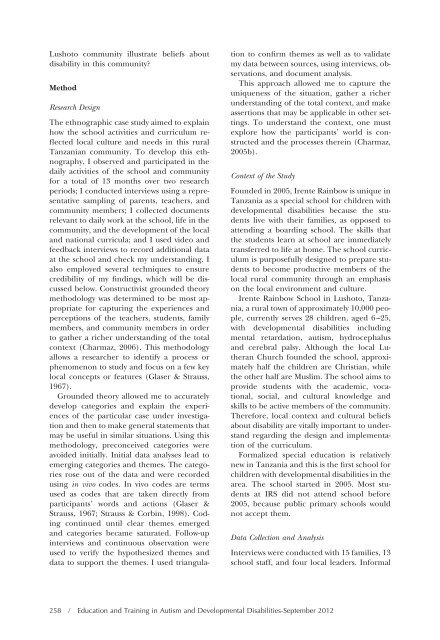etadd_47(3) - Division on Autism and Developmental Disabilities
etadd_47(3) - Division on Autism and Developmental Disabilities
etadd_47(3) - Division on Autism and Developmental Disabilities
You also want an ePaper? Increase the reach of your titles
YUMPU automatically turns print PDFs into web optimized ePapers that Google loves.
Lushoto community illustrate beliefs about<br />
disability in this community?<br />
Method<br />
Research Design<br />
The ethnographic case study aimed to explain<br />
how the school activities <strong>and</strong> curriculum reflected<br />
local culture <strong>and</strong> needs in this rural<br />
Tanzanian community. To develop this ethnography,<br />
I observed <strong>and</strong> participated in the<br />
daily activities of the school <strong>and</strong> community<br />
for a total of 13 m<strong>on</strong>ths over two research<br />
periods; I c<strong>on</strong>ducted interviews using a representative<br />
sampling of parents, teachers, <strong>and</strong><br />
community members; I collected documents<br />
relevant to daily work at the school, life in the<br />
community, <strong>and</strong> the development of the local<br />
<strong>and</strong> nati<strong>on</strong>al curricula; <strong>and</strong> I used video <strong>and</strong><br />
feedback interviews to record additi<strong>on</strong>al data<br />
at the school <strong>and</strong> check my underst<strong>and</strong>ing. I<br />
also employed several techniques to ensure<br />
credibility of my findings, which will be discussed<br />
below. C<strong>on</strong>structivist grounded theory<br />
methodology was determined to be most appropriate<br />
for capturing the experiences <strong>and</strong><br />
percepti<strong>on</strong>s of the teachers, students, family<br />
members, <strong>and</strong> community members in order<br />
to gather a richer underst<strong>and</strong>ing of the total<br />
c<strong>on</strong>text (Charmaz, 2006). This methodology<br />
allows a researcher to identify a process or<br />
phenomen<strong>on</strong> to study <strong>and</strong> focus <strong>on</strong> a few key<br />
local c<strong>on</strong>cepts or features (Glaser & Strauss,<br />
1967).<br />
Grounded theory allowed me to accurately<br />
develop categories <strong>and</strong> explain the experiences<br />
of the particular case under investigati<strong>on</strong><br />
<strong>and</strong> then to make general statements that<br />
may be useful in similar situati<strong>on</strong>s. Using this<br />
methodology, prec<strong>on</strong>ceived categories were<br />
avoided initially. Initial data analyses lead to<br />
emerging categories <strong>and</strong> themes. The categories<br />
rose out of the data <strong>and</strong> were recorded<br />
using in vivo codes. In vivo codes are terms<br />
used as codes that are taken directly from<br />
participants’ words <strong>and</strong> acti<strong>on</strong>s (Glaser &<br />
Strauss, 1967; Strauss & Corbin, 1998). Coding<br />
c<strong>on</strong>tinued until clear themes emerged<br />
<strong>and</strong> categories became saturated. Follow-up<br />
interviews <strong>and</strong> c<strong>on</strong>tinuous observati<strong>on</strong> were<br />
used to verify the hypothesized themes <strong>and</strong><br />
data to support the themes. I used triangula-<br />
ti<strong>on</strong> to c<strong>on</strong>firm themes as well as to validate<br />
my data between sources, using interviews, observati<strong>on</strong>s,<br />
<strong>and</strong> document analysis.<br />
This approach allowed me to capture the<br />
uniqueness of the situati<strong>on</strong>, gather a richer<br />
underst<strong>and</strong>ing of the total c<strong>on</strong>text, <strong>and</strong> make<br />
asserti<strong>on</strong>s that may be applicable in other settings.<br />
To underst<strong>and</strong> the c<strong>on</strong>text, <strong>on</strong>e must<br />
explore how the participants’ world is c<strong>on</strong>structed<br />
<strong>and</strong> the processes therein (Charmaz,<br />
2005b).<br />
C<strong>on</strong>text of the Study<br />
Founded in 2005, Irente Rainbow is unique in<br />
Tanzania as a special school for children with<br />
developmental disabilities because the students<br />
live with their families, as opposed to<br />
attending a boarding school. The skills that<br />
the students learn at school are immediately<br />
transferred to life at home. The school curriculum<br />
is purposefully designed to prepare students<br />
to become productive members of the<br />
local rural community through an emphasis<br />
<strong>on</strong> the local envir<strong>on</strong>ment <strong>and</strong> culture.<br />
Irente Rainbow School in Lushoto, Tanzania,<br />
a rural town of approximately 10,000 people,<br />
currently serves 28 children, aged 6–25,<br />
with developmental disabilities including<br />
mental retardati<strong>on</strong>, autism, hydrocephalus<br />
<strong>and</strong> cerebral palsy. Although the local Lutheran<br />
Church founded the school, approximately<br />
half the children are Christian, while<br />
the other half are Muslim. The school aims to<br />
provide students with the academic, vocati<strong>on</strong>al,<br />
social, <strong>and</strong> cultural knowledge <strong>and</strong><br />
skills to be active members of the community.<br />
Therefore, local c<strong>on</strong>text <strong>and</strong> cultural beliefs<br />
about disability are vitally important to underst<strong>and</strong><br />
regarding the design <strong>and</strong> implementati<strong>on</strong><br />
of the curriculum.<br />
Formalized special educati<strong>on</strong> is relatively<br />
new in Tanzania <strong>and</strong> this is the first school for<br />
children with developmental disabilities in the<br />
area. The school started in 2005. Most students<br />
at IRS did not attend school before<br />
2005, because public primary schools would<br />
not accept them.<br />
Data Collecti<strong>on</strong> <strong>and</strong> Analysis<br />
Interviews were c<strong>on</strong>ducted with 15 families, 13<br />
school staff, <strong>and</strong> four local leaders. Informal<br />
258 / Educati<strong>on</strong> <strong>and</strong> Training in <strong>Autism</strong> <strong>and</strong> <strong>Developmental</strong> <strong>Disabilities</strong>-September 2012

















